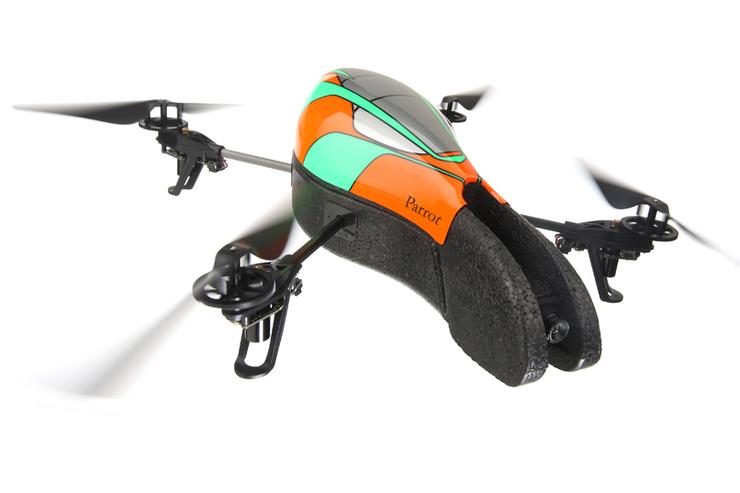The AR.Drone from France-based Parrot is an exciting, fun-to-fly, four-rotor helicopter that can be piloted over Wi-Fi by an iPad, iPod Touch or iPhone. But flying indoors proves tricky and may frustrate inexperienced pilots. The helicopter goes on sale in the U.S. at Brookstone stores on Sept. 3, 2010, for US$299 and is available for pre-order now.
For a video review of the toy, click here.
Getting started
Pairing the unit with an iPad was easy. The toy creates its own wireless network. If there are too many wireless signals in the area, the drone may have trouble pairing, a Parrot spokesman said, but in downtown Boston -- awash with Wi-Fi -- we had no issues.
Wireless cameras
The toy has two cameras, one pointing forward and one pointing down, that stream video back to the controlling device. The cameras seem designed to take advantage of the augmented reality games we saw during CES. In one game an airplane appears on your iPad and you have to control your helicopter to shoot it down. We weren't able to test that game, but we're told that it should be available in the Apple App Store by the end of 2010.
Don't count on the camera to pilot the drone when you can't see it. While the small, front-facing camera has a relatively wide range of view at 93 degrees, it only shoots at 15 frames per second, hardly fast enough to avoid walls and doorways. Outside, though, the cameras give you a unique perspective on the world, especially when you hover the drone amidst trees.
Controlling the toy
The AR.Drone includes basic controls that are on the screen of the iPad, iPhone or iPod Touch. Tilting the iPad makes the drone fly in the same direction as the tilt. When first flying it's best to stand behind it for easier orientation.
The software allows for a lot of customization of flying controls. You can increase and decrease the tilt sensitivity as well as the vertical speed and yaw speed. Making the controls slightly more sensitive makes the helicopter easier to control because you don't need to move the iPad as much.
Indoor flying
Flying the AR.Drone indoors requires a lot of space and minimal obstructions. Parrot suggests using the "indoor hull." Its Styrofoam bumpers ring the propellers and protect them. The indoor hull did indeed protect the rotors, but at a cost. Within two days, our hull fractured in several places and eventually broke into pieces. We repaired the first few fractures with Super Glue and let the repairs sit overnight, but the next day the hull would break in a new place. Parrot offers "mending tape" for about $10 and even has an online instruction video for repairing the hull. If your indoor hull is beyond repair, a replacement can be purchased for about $40.
Outdoor flying
In low wind, outdoor flying proved to be much easier than indoor flying because of large, open spaces and the ability for the drone to ascend quite high. Selecting "outdoor flight" mode allows the drone to compensate for wind. We tested this feature with our hands off the controls and the toy effectively stabilized itself in the wind.
Outdoor flying was much more fun than flying indoors because the drone is quite agile and can fly very quickly in all directions. The main body of the drone, including its propellers, is forgiving. We accidentally crashed the drone several times outdoors, and the propellers and body of the drone stayed fully intact and did not impact future flights.
Battery life
Flying time on a fully charged battery is around 15 minutes. There is a battery indicator on the screen of the iPad and the drone will gently land once the battery gauge hits 12 percent. Charging takes about 90 minutes. If you think you'll be flying a lot, we suggest buying a spare battery for about $45.
Software
The only app available in the App Store when we reviewed the drone was AR.FreeFlight. It allows for full control of the drone including monitoring the video feed from the drone's two cameras. While it works on an iPad, it's designed for the screen size of an iPhone or iPod Touch.
Parrot said that more games, like the augmented reality one we saw at CES, would be available by the end of the year. Parrot has also made an SDK (software development kit) available in hopes that developers will create more apps for the toy. I would enjoy seeing one that allows for video recording. The AR.Drone was initially designed for use with Apple products, but there are also videos online of it being used on an Android phone.
Product durability
The biggest problem we ran into with the AR.Drone was the durability of the indoor hull during our initial testing phase. Being new to the toy, crashes are a near definite and can damage the hull. All of the pieces of the drone are replaceable and a special section of Parrot's website includes repair videos. Parrot said that, "The hull is first and foremost meant to protect the components of the AR.Drone such as the brushless motors, onboard processor and navigation board."
Overall
After becoming comfortable with the AR.Drone's controls and weathering some crashes, the helicopter is a fun toy to fly. Fractures in the indoor hull were frequent during the learning period, but the rest of the toy was quite durable. The success of this product will partly hinge on the developer community and what apps and games are created for it.
Nick Barber covers general technology news in both text and video for IDG News Service. E-mail him at Nick_Barber@idg.com and follow him on Twitter at @nickjb.




